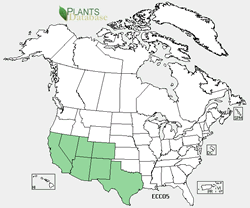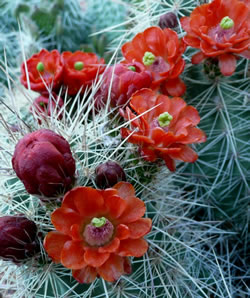Plant of the Week
 Echinocereus coccineus range map. USDA PLANTS Database.
Echinocereus coccineus range map. USDA PLANTS Database.
 Close-up of scarlet hedgehog cactus flowers. Photo by Charlie McDonald.
Close-up of scarlet hedgehog cactus flowers. Photo by Charlie McDonald.
 Another close-up with some flowers still in bud. Photo by Charlie McDonald.
Another close-up with some flowers still in bud. Photo by Charlie McDonald.
 Scarlet hedgehog cactus in a cactus garden in Albuquerque, New Mexico. This plant has grown from a single stem to a plant with nine stems in four years. Photo by Charlie McDonald.
Scarlet hedgehog cactus in a cactus garden in Albuquerque, New Mexico. This plant has grown from a single stem to a plant with nine stems in four years. Photo by Charlie McDonald.
Scarlet Hedgehog Cactus (Echinocereus coccineus)
By Charlie McDonald
Scarlet hedgehog cactus is in the cactus family (Cactaceae), which is a group of about 350 species. These plants are all native to the New World.
Cacti grow mostly in tropical, subtropical, and warm temperate regions, but a few species can tolerate much colder climates. Scarlet hedgehog cactus is in this so-called cold hardy group. Cacti of all types have always held much horticultural fascination. They have unusual shapes and spine textures and many of them have truly spectacular flowers. They have always been popular houseplants. However, the cold hardy cacti provide gardeners in northern climates the opportunity to grow these plants outside and enjoy their beauty in natural settings.
The first tip for growing cold hardy cacti is to plant them in well-drained mineral rich soils. Clay or organic soils that hold water will cause cacti to rot. Put plants in full sun against south or west facing walls. To plant cacti, first allow the plants to dry out, remove them from their pots, shake out all the dirt, and then trim back the roots about one-third their length. Spread the roots in shallow planting holes. Do not bury the bases of the plants with soil, but mulch around them with gravel. Do not water when planting; wait several days for the cut and damaged roots to callus over. Let your cold hardy cacti dry out in the fall. They will shrivel and may become discolored; but this hardens them to survive the cold winter temperatures.
Nursery-grown cacti are available from many sources at reasonable costs. There is no need to dig cacti from native habitats. An internet search using "cold hardy cacti" as the search term will lead you to several suppliers who specialize in these plants.
For More Information
- PLANTS Profile - Echinocereus coccineus, scarlet hedgehog cactus
- Spain, John N. 1997. Growing winter hardy cactus in cold wet climate conditions (pamphlet).
- Nold, Robert. 2008. High and dry: gardening with cold hardy dryland plants. Timber Press, Portland, Oregon.

